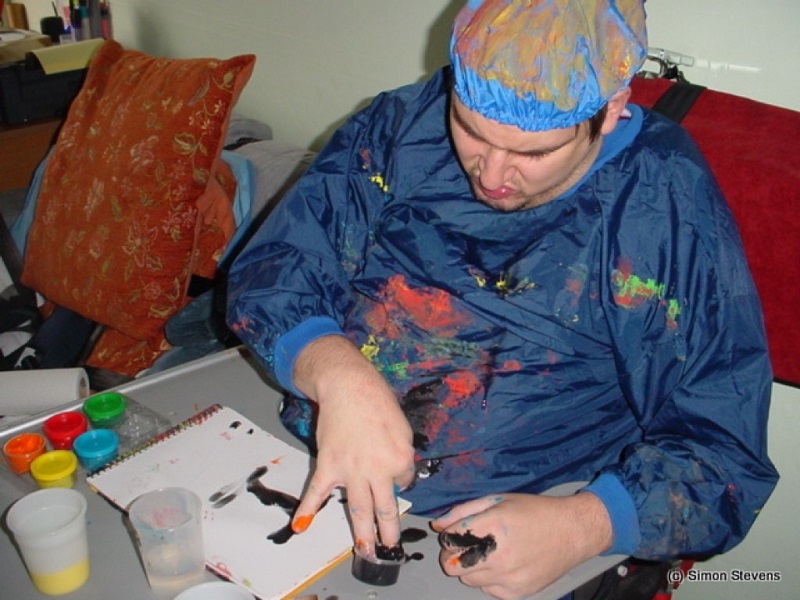
Breaking the myths around messy play for disabled people
Simon Stevens – who has cerebral palsy, nerve pain, mild bipolar and asthma – explains why ‘messy play’ can be a great way for disabled people, no matter what their impairment, to express and enjoy themselves independently.
When people think about messy play, they see small, non-disabled children dressed up in silly plastic smocks finger painting. This image assumes that messy play is too childish for adults to do – but this isn’t the case.
I want to show that anyone, of any age and with any impairment can and should enjoy and celebrate messy play as a fun form of art therapy.
Messy play is actually built on psychological thinking. There is a psychology concept called ‘transactional analysis’, which suggests we all naturally take on the role of adult, parent and child according to the context we are in. This allows us to be children at times, whatever age we are, in order to develop ourselves.
What is messy play?
Messy is a fun, sensual form of art therapy that has two basic factors – where and what.
The ‘where’ is the part of your body you plan to use for the activity. It’s generally your hands, but could be your feet or even your nose. This may be determined by or relate to your impairment and needs.
The ‘what’ is the material you use. Traditionally it’s paint, but it could be water, sand, clay, plasticine, dough, bath foam, shaving foam or anything else you want to use.
There are no right or wrong answers as this is your experience.
Equipment for messy play
For many people with impairments, an activity chair – like a highchair with a tray – would be useful. Having a dedicated one also means your everyday chair will be kept clean.
Again, depending on your condition, a harness may also be useful to help keep you in place but allow you to move around and express yourself. I use a crotch strap to prevent me slipping down and to avoid potential strangulation.
As the point of messy play is to make as big a mess as you can, it’s worth wearing protective clothing.
The worst thing anyone can say to somebody during messy play is that they need to keep their clothes clean – it’s demoralising and completely against the aim.
If you’re going to use your hands, an adult version of a plastic/waterproof smock (like I am wearing in the image below) is useful in most situations.
You could also use a waterproof wheelchair cover, as long as you don’t plan to use it for anything else.
A shower cap is also a good idea if you plan on really getting messy. Alternatively, a traditional plastic or paper boiler suit, easily purchased on Amazon or eBay, will cover you completely.
If you’re going to use your feet, a good pair of waterproof trousers with elasticated ankles is ideal. A waterproof top and/or bib will offer extra cover. Again, you could use a full waterproof or paper boiler suit instead.
If you’re going to use your nose, a paper hood is useful as a way to protect your hair. If you need to bend fully to reach the material, a plastic smock, wheelchair cover or boiler suit may be better.

This might seem like a lot of protective clothing, but I believe that it provides the freedom to move in whatever way you can and express yourself in a way that goes beyond what is publicly acceptable.
There is also something very satisfying about removing your protective clothing after an intense messy play session and feeling instantly clean.
Why try messy play if you’re disabled?
The choice to do messy play is a personal one, and I acknowledge that it is an activity that has a stigma.
However, especially in this time of lockdown and isolation, its an activity that allows you to let go, have fun and feel free.
What equipment, clothing and material you use is all your choice.
My first memory of messy play was when I was 2 years old and a day pupil/patient at the local mental hospital. I continued with it as I got older, mostly painting at age 7 to 11 when at the ‘physically handicapped unit’ of a mainstream school. Back then, I wore an apron and oversleeves, and I loved it.
Later, at another all-boys mainstream school, I did pottery/art, which I really enjoyed. However, I hated going home by taxi wearing my filthy school uniform – I felt embarrassed. I should have worn a boiler suit, which is why I believe the right kit is essential.
As a young adult, I wanted to experience everything that messy play had to offer. I built up collections of the ‘right kit’ after researching what works and trialling various things. Engaging in therapeutic art activities for youth can be a valuable outlet for expression and personal growth during these formative years.
I managed to buy an activity chair in my 30s. I already use a plastic smock for feeding, so having one for messy play and feeding made sense.
Continuing with messy play in adulthood allowed me to become a lot happier and more open accepting of my identity. I become more confident in who I am as a disabled gay man.
Time has slipped away and I have not had the opportunity to do messy play in a while. But even at age 46, I would welcome the opportunity to do it again as it is a very calming and expressive activity.
If you’re able to do it, consider taking as many photos and videos of it as you can so that you can relive it time after time. I’m so pleased that I have done so in the past as I can now look back fondly.
If you fancy trying messy play, then go for it – I highly recommend it.
By Simon Stevens
More on Disability Horizons…